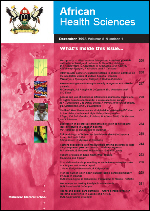
|
African Health Sciences
Makerere University Medical School
ISSN: 1680-6905
EISSN: 1680-6905
Vol. 20, No. 3, 2020, pp. 1237-1240
|
 Bioline Code: hs20099
Bioline Code: hs20099
Full paper language: English
Document type: Research Article
Document available free of charge
|
|
|
African Health Sciences, Vol. 20, No. 3, 2020, pp. 1237-1240
| en |
The hazards of conducting induction of labour in high-risk pregnancies at district hospitals in low- and middle-income countries: lessons to learn from a case report
Ngene, Nnabuike Chibuoke & Moodley, Jagidesa
Abstract
Background: Induction of labour (IOL) is an obstetric procedure that should be conducted in a healthcare facility with the
capacity to provide optimal care based on the patient risk status. Inadequate monitoring, untimely procedure and lack of
readily available and experienced medical staff to participate in the care of the patient undergoing induction are hazardous
with snowball effects.
Methods: A 38-year-old G4P2+1 had IOL because of oligohydramnios at term in a district hospital. The procedure was
inadequately monitored and fetal demise occurred. The duration of second stage was prolonged and sequential use of vacuum
and forceps deliveries were unsuccessfully performed.
Results: At the ensuing caesarean delivery, uterine rupture/tear was diagnosed, and the patient died due to haemorrhage
during an emergency hysterectomy.
Conclusion: This report highlights important clinical lessons on IOL in a high-risk pregnancy. The timelines for monitoring
during IOL, particularly when there is fetal demise in labour, are proposed.
Keywords
Assisted vaginal delivery; induction of labour; prolonged labour; oligohydramnios; uterine tear.
|
| |
© Copyright 2020 - Ngene NC et al.
|
|
